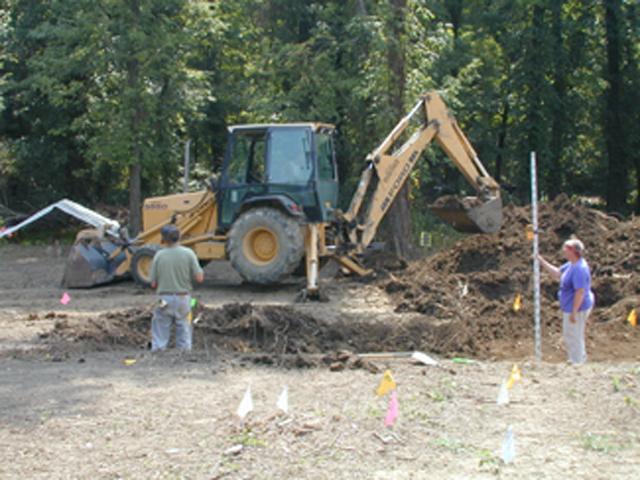Bone Bank Archaeological Research
Posey County, Indiana
Rescue Excavations at the Bone Bank Archaeological Site in Southwestern Indiana
 Introduction
Introduction
 Indiana's First Archaeological Excavation
Indiana's First Archaeological Excavation
 Survey and Testing
Survey and Testing
 Significance
Significance
 Project Goals
Project Goals
 Research Stages
Research Stages
 Expected Results
Expected Results
 Bone Bank in 2000
Bone Bank in 2000
 Planning for 2001
Planning for 2001
 Current Work
Current Work
 In the News
In the News
 Fall 2001 Lecture
Fall 2001 Lecture
 References
References
 Geomorphological History
Geomorphological History
 Links
Links

August 29 to September 2, 2001
After excavation blocks and trenches were layed out according to grid, we used a backhoe to remove plow disturbed soils and recent alluvium that comprise level 1. In Block 2, a laser level (loaned to the project by Indiana State University, Department of Anthropology) was used to guide the mechanical excavation to the target elevation for the base of 1 (106.3 m ASL). As expected, the tree stumps and roots certainly made excavation difficult, but there were far more stumps present than were visible on the ground surface!!!

FOREGROUND: Following mechanical excavation, the loose dirt in Block 2 was removed by hand excavation. Then the mud that followed a 2-inch downpour was allowed to dry. Mississippian midden deposits are present just below the base of the excavation at elevation 106.3.
BACKGROUND: At Block 1 on higher ground, we began shovel scraping the base of excavation units to search for pit and wall trench features that intrude the subsoil. Portable canopy-type tents (loaned by the Paul Weimer family) made this hot, hard work considerably easier.

Block 2: Initial layout of excavation units within a 2 x 10 m area. Strings mark the sides of Units 4A-4J and 4K-4T. Nails with pink tape mark the corners of the units.

Previous Weeks
First Week (August 22-26, 2001)
Second Week (August 29 - September 2, 2001)
Third Week (September 5 - September 9, 2001)
Fourth Week (September 12 - September 16, 2001)
Fifth Week (September 19 - September 23, 2001)
Sixth Week (September 26 - September 30, 2001)
October (October 1 - October 26, 2001) Part 1
October (October 1 - October 26, 2001) Part 2
Thanks Everyone!
Current Week
Return to Top
Last updated on 9/17/2001
Send Comments to: munsonc@indiana.edu
Site sponsored by Indiana University
 Introduction
Introduction
 Indiana's First Archaeological Excavation
Indiana's First Archaeological Excavation
 Survey and Testing
Survey and Testing
 Significance
Significance
 Project Goals
Project Goals
 Research Stages
Research Stages
 Expected Results
Expected Results
 Bone Bank in 2000
Bone Bank in 2000
 Planning for 2001
Planning for 2001
 Current Work
Current Work
 In the News
In the News
 Fall 2001 Lecture
Fall 2001 Lecture
 References
References
 Geomorphological History
Geomorphological History
 Links
Links



